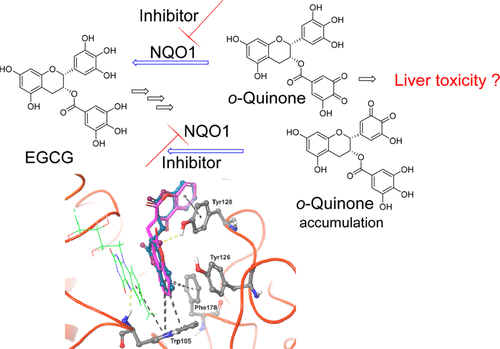当前位置:
X-MOL 学术
›
Chem. Res. Toxicol.
›
论文详情
Our official English website, www.x-mol.net, welcomes your
feedback! (Note: you will need to create a separate account there.)
Potential Modulation of Human NAD[P]H-Quinone Oxidoreductase 1 (NQO1) by EGCG and Its Metabolites—A Systematic Computational Study
Chemical Research in Toxicology ( IF 3.7 ) Pub Date : 2020-09-25 , DOI: 10.1021/acs.chemrestox.9b00450 Pankaj Pandey , Bharathi Avula , Ikhlas A Khan , Shabana I Khan , Victor J Navarro 1 , Robert J Doerksen , Amar G Chittiboyina
Chemical Research in Toxicology ( IF 3.7 ) Pub Date : 2020-09-25 , DOI: 10.1021/acs.chemrestox.9b00450 Pankaj Pandey , Bharathi Avula , Ikhlas A Khan , Shabana I Khan , Victor J Navarro 1 , Robert J Doerksen , Amar G Chittiboyina
Affiliation

|
At high doses, green tea extracts and green tea’s major active constituent, (−)-epigallocatechin gallate (EGCG), despite their generally perceived health benefits, have been suspected to cause hepatotoxicity in certain human populations. It has been reported that o-quinone metabolites of gallic acid or EGCG are causative agents for this hepatotoxicity. However, no experimental information is available at the molecular level on the possible role of NQO1 in the detoxification of EGCG and its metabolites, including reactive intermediates. In the present study, we investigated the possibility of NQO1 inhibition by EGCG and its metabolites by studying their interaction profiles and binding mechanism at the active site of NQO1 using molecular docking, binding free energy calculations, and molecular dynamics (MD) simulations. The binding free energy calculations showed that some metabolites exhibited strong predicted binding affinity and found that the binding orientation of the EGCG metabolites overlapped with that of dicoumarol found in an NQO1 X-ray crystal structure. The results suggest that these metabolites may act as strong NQO1 inhibitors, highlighting the need for experimental validation of this with appropriate biological methods. The Prime MM-GBSA computed average binding free energies after MD simulations of compounds 1, 2, 24, 31, and 33 revealed that these compounds highly favored van der Waals (VdW) and Coulombic interactions with NQO1. In addition, the MD results revealed that selected EGCG metabolites formed a stable and strong complex with NQO1, with amino acids W105, Y126, Y128, H161, F178, H194, F232, and F236 being critical for potential NQO1 binding. The current results together with experimental data as well as studies of the polymorphisms of NQO1 (especially C609T) may explain the observed idiosyncratic hepatotoxicity caused by the consumption of green tea and its constituents.
中文翻译:

EGCG 及其代谢物对人 NAD[P]H-醌氧化还原酶 1 (NQO1) 的潜在调节——系统计算研究
尽管人们普遍认为绿茶提取物和绿茶的主要活性成分 (-)-表没食子儿茶素没食子酸酯 (EGCG) 对健康有益,但人们怀疑在高剂量下,它们会在某些人群中引起肝毒性。据报道,o没食子酸或 EGCG 的醌代谢物是导致这种肝毒性的原因。然而,没有关于 NQO1 在 EGCG 及其代谢物(包括反应中间体)解毒中可能作用的分子水平上的实验信息。在本研究中,我们通过使用分子对接、结合自由能计算和分子动力学 (MD) 模拟研究它们在 NQO1 活性位点的相互作用谱和结合机制,研究了 EGCG 及其代谢物抑制 NQO1 的可能性。结合自由能计算表明,一些代谢物表现出很强的预测结合亲和力,并发现 EGCG 代谢物的结合方向与 NQO1 X 射线晶体结构中发现的双香豆素的结合方向重叠。结果表明,这些代谢物可能充当强 NQO1 抑制剂,强调需要用适当的生物学方法对此进行实验验证。Prime MM-GBSA 计算化合物的 MD 模拟后的平均结合自由能1,2,24,31,和33显示,这些化合物非常有利的范德华(VDW)中并用NQO1库仑相互作用。此外,MD 结果显示,选定的 EGCG 代谢物与 NQO1 形成稳定且牢固的复合物,其中氨基酸 W105、Y126、Y128、H161、F178、H194、F232 和 F236 对潜在的 NQO1 结合至关重要。目前的结果连同实验数据以及 NQO1(尤其是 C609T)多态性的研究可以解释观察到的由绿茶及其成分的消费引起的特异质肝毒性。
更新日期:2020-11-16
中文翻译:

EGCG 及其代谢物对人 NAD[P]H-醌氧化还原酶 1 (NQO1) 的潜在调节——系统计算研究
尽管人们普遍认为绿茶提取物和绿茶的主要活性成分 (-)-表没食子儿茶素没食子酸酯 (EGCG) 对健康有益,但人们怀疑在高剂量下,它们会在某些人群中引起肝毒性。据报道,o没食子酸或 EGCG 的醌代谢物是导致这种肝毒性的原因。然而,没有关于 NQO1 在 EGCG 及其代谢物(包括反应中间体)解毒中可能作用的分子水平上的实验信息。在本研究中,我们通过使用分子对接、结合自由能计算和分子动力学 (MD) 模拟研究它们在 NQO1 活性位点的相互作用谱和结合机制,研究了 EGCG 及其代谢物抑制 NQO1 的可能性。结合自由能计算表明,一些代谢物表现出很强的预测结合亲和力,并发现 EGCG 代谢物的结合方向与 NQO1 X 射线晶体结构中发现的双香豆素的结合方向重叠。结果表明,这些代谢物可能充当强 NQO1 抑制剂,强调需要用适当的生物学方法对此进行实验验证。Prime MM-GBSA 计算化合物的 MD 模拟后的平均结合自由能1,2,24,31,和33显示,这些化合物非常有利的范德华(VDW)中并用NQO1库仑相互作用。此外,MD 结果显示,选定的 EGCG 代谢物与 NQO1 形成稳定且牢固的复合物,其中氨基酸 W105、Y126、Y128、H161、F178、H194、F232 和 F236 对潜在的 NQO1 结合至关重要。目前的结果连同实验数据以及 NQO1(尤其是 C609T)多态性的研究可以解释观察到的由绿茶及其成分的消费引起的特异质肝毒性。











































 京公网安备 11010802027423号
京公网安备 11010802027423号